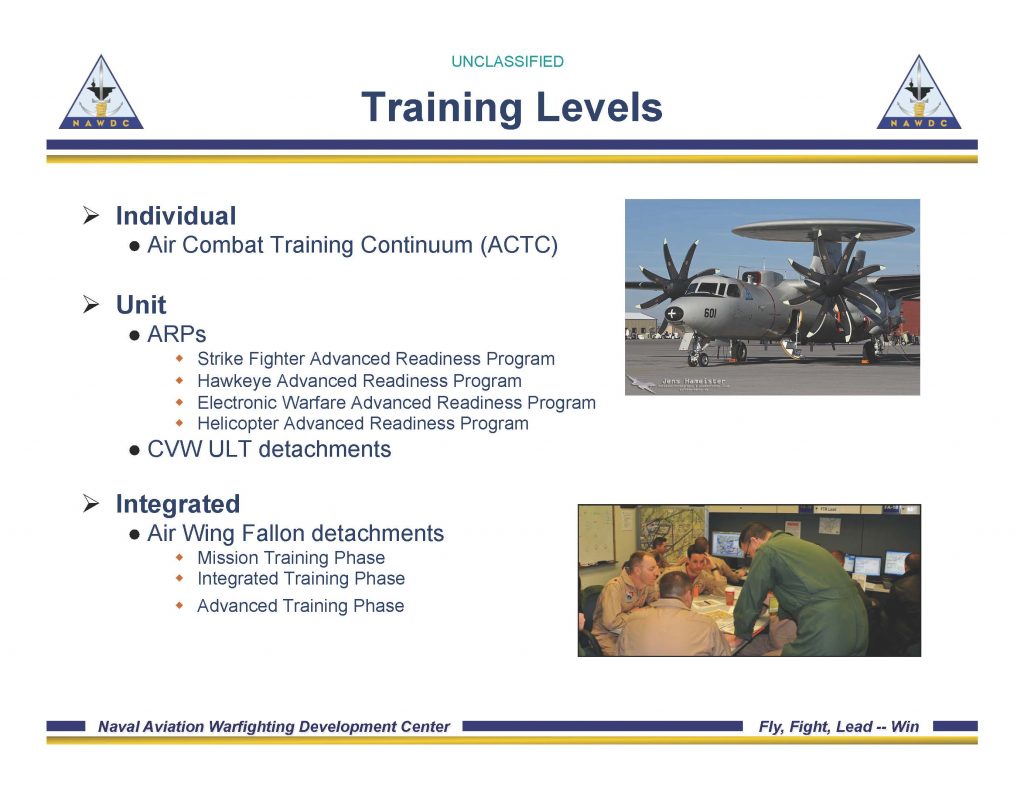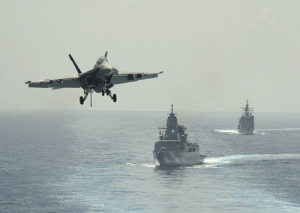2017-08-17 By Edward Timperlake and Robbin Laird
When we were last at Fallon in 2014, we had a chance to talk to the officers involved in the last phase of training prior to going to the Carrier, namely what they call Air Wing Fallon. Naval Air Station Fallon is known as the “carrier in the desert” and Air Wing Fallon is the final or pre-deployment phase of training down on the Carrier to the desert as the CAG deploys to the carrier at sea.
During that visit we discussed Air Wing Fallon with CDR (S) Jayson “Plato” Eurick, Air Wing Training Officer, at Naval Strike and Air Warfare Center, Fallon Naval Air Station.
Training is about getting ready for deployment and supporting deployment, which is certainly a broad concept of training.
“We ensure that they (the air wing) get up to speed on all of the information that is currently taking place in theater.
“We don’t train Air Wing Fallon for a specific theater or country, we give them a broad brushed training, but we ensure that they get the information that is coming directly back from the guys overseas, in this case, the USS Bush.
“And then we train them.”
During this visit we discussed the Air Wing Fallon phase of training with Commander “Humble” Pritchard, Lt. Chris “Reek” Neidemeyer and Lt. Neal “Shaky” Dunn.
The officers represent a cluster of experience with CDR Pritchard having more than 830 “cats and traps,” Neidemeyer just back from his first fleet tour and Lt. Dunn just back from deployment with VFA-103 “the Jolly Rogers” based at Naval Air Station Oceana, Virginia.
The responsibility of N-5 which these officers represented is identified as follows by the US Navy.
N5: Responsible for training Naval aviation in advanced Tactics, Techniques and Procedures (TTP) across assigned combat mission areas at the individual, unit, integrated and joint levels, ensuring alignment of the training continuum; to set and enforce combat proficiency standards; to develop, validate, standarize, publish and revise TTPs.
Also provides subject matter expertise support to strike group commanders, numbered fleet commanders, Navy component commanders and combatant commanders; to lead training and warfighting effectiveness assessments and identify and mitigate gaps across all platforms and staffs for assigned mission areas as the supported WDC; and collaborates with other WDCs to ensure cross-platform intergration and alignment.
https://www.cnic.navy.mil/regions/cnrsw/installations/nas_fallon/about/nawdc.html
During our last visit to Fallon, the readiness challenged was highlighted as a growing problem.
This visit to Fallon highlighted the reality of what readiness shortfalls meant.
And the importance of this challenge is heightened as potential adversaries ramp up their capabilities and training time as well.
“You would read about potential adversaries and they’re flying 120 hours a year.
“You’d sit there and go that’s ridiculous.
“Who survives on 120 hours a year?
“We do that now.
“I don’t think anybody trains like us, and I think in a high end fight, they will not be able to keep up with the level of professionalism and the quality of people we’ve got, but I’m going to assume they can until proven otherwise.”

Put in simple terms, the Navy goes through a series of training cycles.
If fully equipped and funded for each phase of the training cycle, then all the training tasks can be accomplished and when the aviator moves to the next phase they do not need to learn tasks which they should have learned earlier.
But because of readiness shortfalls, the catch up in each phase of training has become a regular challenge.
This means that at Air Wing Fallon, some of the skills which should have been learned earlier need to be caught up in the pre-deployment phase of training.
It is obviously important that this challenge be met and rectified.
Air Wing Fallon prepares as the earlier quote indicates the CAG for a variety of settings and scenarios, not just what currently deployed CAGs are facing and doing.
And to do this they involve external assets with which the CAG will operate as well.
 MEDITERRANEAN SEA (June 14, 2013), an F/A-18F Super Hornet assigned to the Jolly Rogers of Strike Fighter Squadron (VFA) 103 approaches the flight deck of the aircraft carrier USS Dwight D. Eisenhower (CVN 69) for an arrested recovery
MEDITERRANEAN SEA (June 14, 2013), an F/A-18F Super Hornet assigned to the Jolly Rogers of Strike Fighter Squadron (VFA) 103 approaches the flight deck of the aircraft carrier USS Dwight D. Eisenhower (CVN 69) for an arrested recovery
For the non-naval aviator, the way to think about is that the CAG works its relationship with organic carriers assets, such as with the strike aircraft, Growlers onboard and Hawkeyes.
This part of the concentrate circle expands as the reach of the air wing is extended by its ability to work with assets external to the carrier.
Air Wing Fallon provides training for working with non-organic assets which will vary in terms of what is available and present at Fallon during Air Wing Fallon training.
But obviously as technology evolves and new platforms being added such as P-8s, Tritons, F-35s, etc. the external reach of the carrier is expanded as well.
“The concern that we have is making sure that the CAG is prepared for all contingencies, which is why we have a wide scope when it comes to what we put them through, and in addition, we’ve incorporated realistic scenarios, so they know how painful the real world is going to be.
“They need to learn to use off board and on board systems.
“They need to learn how to work with the E2 or the AWACS to be able to put the puzzle together to figure out if the ROE is met and staying within the allowable threat level or risk level.”
With the evolution of the threat, training needs to evolve as well.
There clearly is a need to work in a “dark environment” where jamming is a key threat and challenge.
There is a need to leverage the digital battlefield and to change procedures allowing for faster upgrades to the data in the strike force to ensure that stovepiped security arrangements block the combat aviators from having the data they need to prevail in the digitally informed battlespace.
This is a particular challenge onboard the carrier, as the crews need to build their own data and crypto loads.
The coming of the F-35 will accentuate this challenge and will need to be solved to ensure that the CAG gets full value out of an information superiority strike asset.
In short, there is a clear need to align security, data flows and sustainment approaches with the evolving CAG and its ability to work with external assets.
“How we acquire, how we sustain, and how we secure our forces needs to work and be aligned for an integrated, high intensity warfare enabled force.
“This is a key challenge which must be met to prevail in combat”
Editor’s Note:
One of the critical advances in the coming together of many 21st Century technological advances is the exponential growth in ISR (Intelligence, Surveillance and Reconnaissance) is a critical component of a countries military battle planning and execution, and that can be a very good thing.
However, what we picked up at Fallon builds on some of the comments we heard in our visit to the Navy Jax, P-8, Triton community.
To put it in our words the “mechanics” of getting actionable timely intelligence to the aircrews and Fleet commanders is often a weak link. The “Intel” can be there but the process is often not helpful. It can be both a macro issue and a micro issue.
On a “macro” level there is a move to send “Intel” up first to higher command then back down. This challenge was discussed at Jax Navy in the context of declaring Triton ocean surveillance information part of a national strategic collection effort. Of course it is an easy solution to let the Intel flow both up and down concurrently.
Hopefully this is in work toward a successful resolution.
On a “micro” level with the advent of much more advanced classified com/crypto links the combat aircrew must have the latest way to receive the Intel during the battle. This can take effort pre-take off.
It is a potential leadership issue to ensure the correct balance is struck between preparing the air wing for combat and the actual warriors who are flying into harms way.
In the Vietnam War and also Cold War “hot scrambles” the fear of the Intel community was to not release all electronic signal counter measures because they thought it important to keep some capabilities in reserve for the possibility of a US/USSR strategic engagement.
Often times that attitude in those years was sarcastically discussed as the activity of having a “squirrel mentality” in burying Intel. It required leadership at all times to keep the appropriate balance between the combat warriors and support functions.
When missiles are flying and people and platforms are dying, the function of all the shooters in the Fleet to bring weapons on is the difference between winning and losing and life and death.
Getting the most significant information to the combat crews in a timely manner is everything.
Everything else is, to paraphrase the “Red Barron,” Manfred Von Richthofen, “rubbish.”

